Ted Stevens Anchorage International Airport Master Plan Update
**THE COMMENT PERIOD FOR THIS MEETING IS NOW CLOSED**
Welcome to the Anchorage Master Plan Online Public Meeting!
The purpose of this Online Public meeting is to share the materials that were presented at the September 14, 2023, in-person public meeting. This online platform is open from September 14th to the 28th 2023. Your feedback is important to us! You may visit the last station of this meeting or visit the website at ancmpu.com.
Navigating this site:
This site is best viewed on your desktop or laptop computer at 100% view. You may click the tabs in the left navigation to visit each poster station. You may click on each poster to enlarge it. If you prefer to experience this Online Meeting in text format only, visit the Text Only page of this meeting.
Begin by choosing a station button below

Welcome
Welcome to the Anchorage Master Plan Online Public Meeting.
The purpose of this Online Public Meeting is to share the materials that were presented at the September 14, 2023, in-person public meeting. This online platform is open from September 14th to the 28th.
Feedback
You may visit the last station of this meeting or visit the website at ancmpu.com.
Documents
You will also find documents presented at the in-person meeting linked below.
The Agenda
-
- 5:30 PM Public Meeting Begins
- 5:45 PM Presentation
- 7:30 PM Public Meeting Ends
The ANC Master Plan Update (MPU) will provide recommendations to airport facility, operations, and cargo growth based off aviation forecasts and facility requirements.
*** NOTE***
The Project is a separate project working independently of the ANC MPU. For NorthLink questions please contact the NorthLink Project team at (907) 931-6350. Email them at: [email protected] or visit www.northlinkaviation.com.

What is an Airport Master Plan?
The Federal Aviation Administration (FAA) recommends that all airports have up-to-date master plans. A master plan serves as a blueprint for an airport’s long-term development and is typically updated every 5 to 7 years. The Airport last completed a Master Plan Update from 2012 to 2014. Since then, many changes have occurred that merit a new Master Plan Update. Of note, the Alaska and world economies have changed due to the rise of e-commerce, which has impacted cargo traffic. In Alaska, a prolonged recession impacted the local and state economies. The COVID-19 pandemic drastically altered travel patterns for several years but they appear to be recovering to near normal passenger levels. Tourism in Alaska continues to grow.
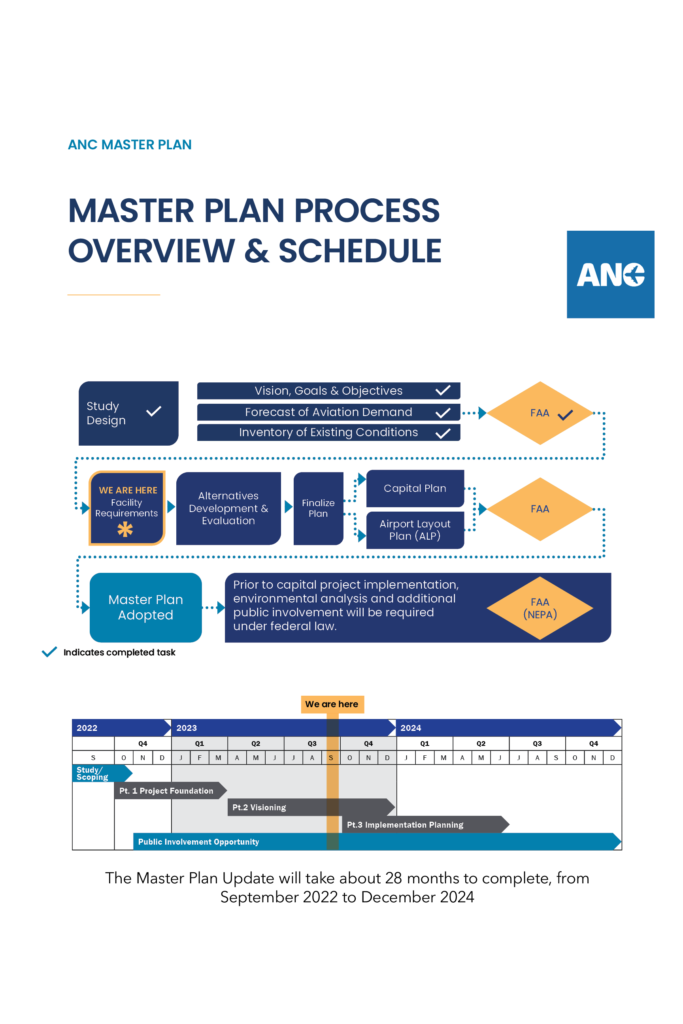
Master Plan Process Overview & Schedule
Study Design
We review previous studies to develop a well-defined project approach that follows FAA guidance.
Vision, Goals & Objectives
Goals and objectives for the Master Plan Update are defined.
Aviation Forecast
Using feedback from the major airline stakeholders, develop an Aviation Forecast of projections for passengers, cargo, and operations at ANC Airport. The forecast will include insight on future activity and will be presented to the public after the data is accepted by FAA.
Inventory
Update any changes that have occurred since the previous master plan update. Airport staff, tenants, and stakeholders help identify changes in the existing conditions.
Facility Requirements
Facility requirements are primarily determined by technical analysis of existing facility data relative to forecast demand. For this Master Plan Update, facility requirements will rely upon demand-level trigger points to establish a need for additional throughput capacity. A trigger point is the point at which throughput exceeds an established facility capacity, degrading facility performance or level of service and triggering a need for an improved or expanded facility. This stands in contrast to using a calendar to establish a timeline for facility improvements.
Alternatives Development & Evaluation
Prepare conceptual development plans for meeting the established facility requirements. Typically, several solutions or alternatives are conceived to meet future facility needs.
The alternatives are screened using evaluation criteria to identify those that best meet the Airport’s needs. Multiple alternatives are then refined and combined to more fully address airport needs and evaluation criteria. The refined alternative moves forward.
Final Master Plan Report
The Facilities Implementation Plan provides recommendations on how to implement the Master Plan Update and the preferred alternative. This often includes a development schedule, cost estimates, phasing plan, identification of interrelated projects, and other special considerations. To-scale Airport drawings that make up the Airport Layout Plan (ALP) will be updated, depicting proposed developments that make up the selected alternative.
Master Plan Update conditions, findings, and development plans will be documented in a draft and a final report. The report will include a summary of public involvement activities and outcomes. The report will also include a financial feasibility analysis for identified Airport improvements. The final report will be published and made available to the public. The Master Plan Update is anticipated to take roughly 24 months to complete, with a final completion date of December 2024. The schedule may change. The best way to stay up to date is to sign up for email updates.
Schedule
The Master Plan Update is anticipated to take roughly 24 months to complete, with a final completion date of December 2024. The schedule may change. The best way to stay up to date is to sign up for email updates.
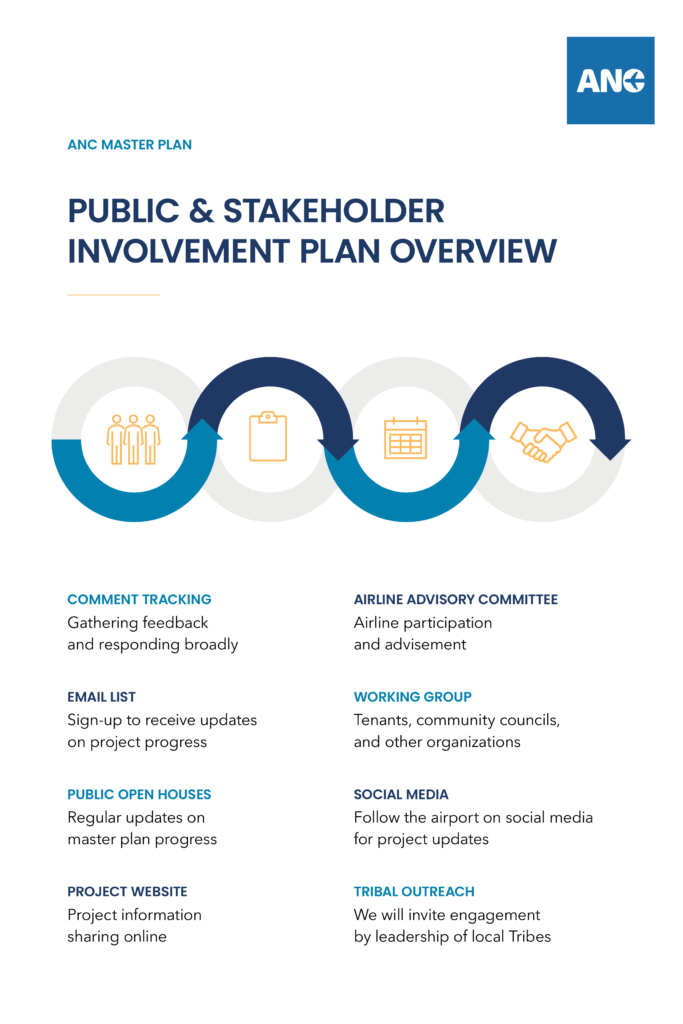
Public and Stakeholder Involvement Plan
The Public Involvement Plan identifies the steps in the Master Plan Update process and explains how public input can shape the plan. At each key decision point, the Master Plan Update project team and the Airport will solicit public input prior to the Airport making a decision.
Public Meetings will be held at each of these key points in the decision-making process:
-
- Goals & Objectives/Inventory
- Forecast
- Facility Requirements & Draft Alternatives
- Final Report
Advisory Committees
The Airport is convening two advisory committees comprised of airline professionals and community leaders. The purpose of the Airline Advisory Committee and the Working Group is to provide information and guidance on specific aspects of Master Plan Update development and to inform the decision-making process.
Online
Visit us at ancmpu.com to sign up for email updates, review materials, leave a comment, or reach the team.

Goals and Objectives
The goals and objectives (G&O) will be used to evaluate alternative actions for meeting the primary purpose of the Master Plan Update: evaluating the best course of action for Airport development to meet future aviation demand.
The following goals were identified at the project’s outset in a staff and airport leadership workshop and are modestly evolved from the prior Master Plan. Project goals are broad statements about what the Airport hopes to achieve through the Master Plan Update process.
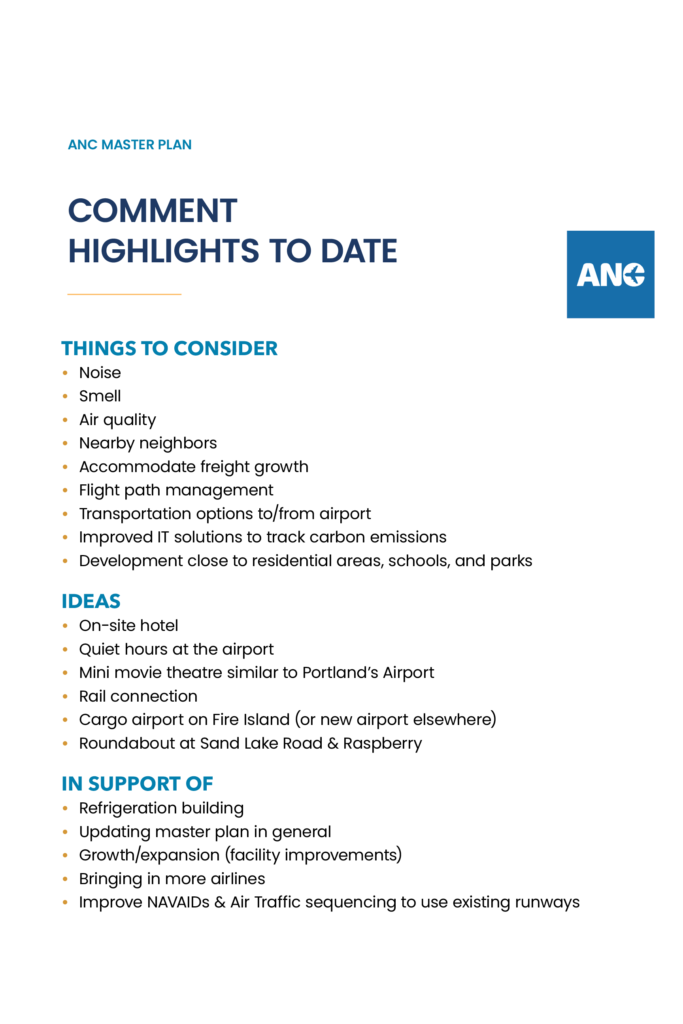
Public Meeting Comments
We are listening to you! We have received over a total of 26 public comments through email, phone calls, and public meetings to date. Most of the comments are in favor of the airport master plan and expansion, with some concerns to consider when planning.

Forecast: Cargo & General Aviation
CARGO
Anticipated rate of growth for cargo is 2.8% per year over a 20-year planning period.
What does that mean?
How busy is ANC today?
- ANC was the world’s 3rd busiest cargo airport in 2022 at 3.6 million tonnes
Who is the busiest?
- Hong Kong – 1st globally at 4.2 million tonnes
- Memphis – 2nd globally at 4.1 million tonnes
Who are ANC’s peer airports (in 2022)?
- ANC does not have a cargo peer – ANC is a unique cargo facility with significant landed weight but relatively limited cargo handling and processing.
GENERAL AVIATON
Anticipated rate of growth for general aviation is 1.0% per year over the 20-year planning period. ANC GA activity will grow slightly and follow U.S. trends and GA operations account for about 13% of all operations at ANC today and are expected to decrease to about 11% of operations in 2042.

Forecast: Operations & Passenger Activity
The Aviation Forecast has been approved by the FAA in August 2023.
OPERATIONS
Anticipated rate of growthi is 1.8% per year.
What does this mean? How busy is ANC today?
2022 was ANC’s busiest recent year:
- 226,346 operations
- 26th Busiest US Airport (Source: ACI-NA)
Who is the busiest?
- Busiest US Airport: Atlanta – 707,000 ops
- Seattle ranks 11th – 375,000 ops
Who are ANC’s peer airports (in 2022)?
- A little smaller – MEM (Memphis, TN) – 215,000 ops
- A little larger – SFO (San Francisco, CA) – 266,000 ops
How busy might ANC be in 10 years?
- About as busy as SFO is today.
PASSENGER ACTIVITY
Anticipated Rate of Growth for passenger activity is 2.3% per year over the 20-year planning period.
What does this mean?
How busy is ANC today?
2019 was ANC’s busiest year
- 7 million enplanements
- 59th Busiest US Airport
Who is the busiest?
- Atlanta ranks 1st – 54 million enplanements (2019)
- Seattle ranks 11th – 25 million enplanements (2019)
Who are ANC’s peer airports?
- MKE in Milwaukee, WI is a little busier than ANC

Facility Requirements
Facility requirements identify the scale and type of improvements ANC will need to safely and comfortably accommodate forecast growth for future years. The following facility requirements are associated with planning activity levels that trigger the need for improvements at specific demand levels.

Airfield Facility Requirements
Based on FAA Airport Design Standards, all aircraft are adequately served by existing runway lengths. Some minor improvements suggested to meet current FAA standards include increasing length of Runway 25L’s blast pad and improving the angle of the Crossfield Taxiway. Taxiway Z expansion is scheduled for phased construction from 2023-2029, which will require some other facilities to be relocated.

Terminal Facility Requirements
Passenger growth will require both gate expansions in the South Terminal as well as enhanced capacity for airline ticketing, security screening checkpoints, and baggage handling systems.

Landside Facility Requirements
Parking for both employees and passengers do not adequately serve the needs of the Airport. In comparison to similar airports, Anchorage is below peers in annual passenger counts to parking ratios.
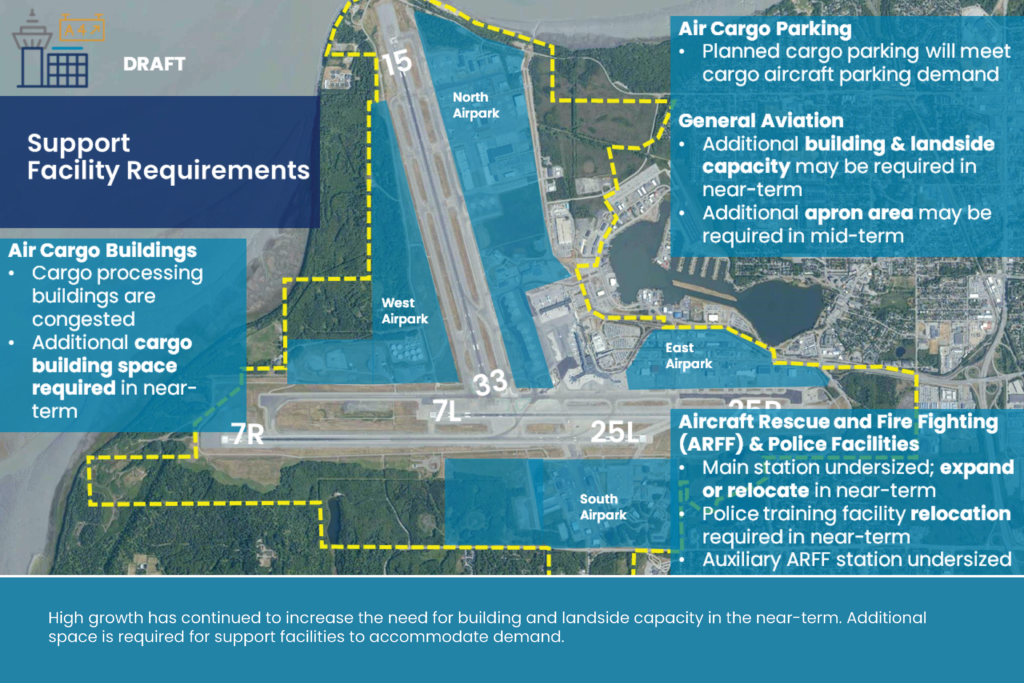
Support Facility Requirements
High growth has continued to increase the need for building and landside capacity in the near-term. Additional space is required for support facilities to accommodate demand.
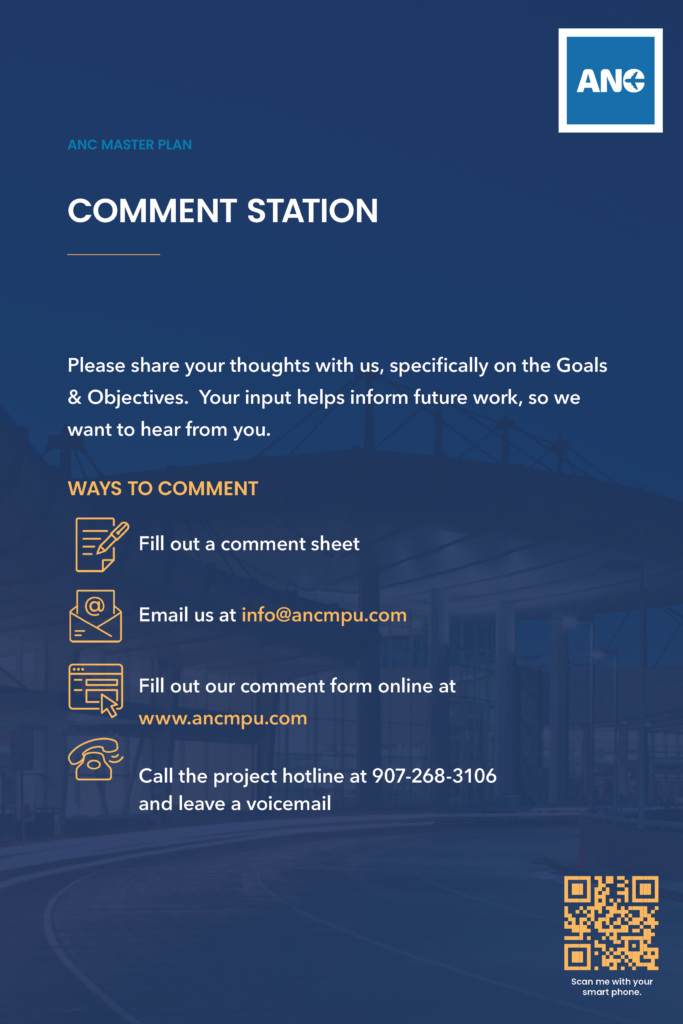
Goals and Objectives 7: Resilience
Please share your thoughts with us, specifically on the Goals & Objectives. Your input helps inform future work, so we want to hear from you.
Ways to Comment:
- Fill out a comment sheet
- Email us at [email protected]
- Fill out our interactive comment form at ancmpu.com
- Call the project hotline at 907-268-3106 and leave a voicemail
Document Station
Downloadable documents provided at the September 14, 2023 in-person public meeitng. Adobe Acrobat Reader is required to view these documents.
